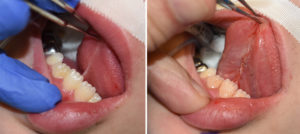Being tongue-tied is a common phrase that implies one can not speak due to a loss of words. But being tongue-tied is also a real medical condition that is a well known congenital oral defect known as ankyloglossia. It occurs when the attachment of the tongue (lingual frenulum)) is unnaturally short.
The lingual frenum is a web of mucous membrane that connects the underside of the tongue to the front of the floor of the mouth at the locations of Wharton’s ducts. During fetal development the lingual frenum serves to keep the tongue fixed into position as it grows forward as the oral structures around it form. If some abnormality of the frenum occurs during this process, the frenum remains short and its lack of adequate length is evident at birth. Very short frenulum attachments can cause numerous functional problems with speech, feeding and oral hygiene/function.

The lingual frenuloplasty is an uncomplicated procedure that its highly effective and has a short operative time. Its only potential complications are disruption of the salivary ducts or the lingual veins, both of which are easily avoided.
Dr. Barry Eppley
Indianapolis, Indiana


